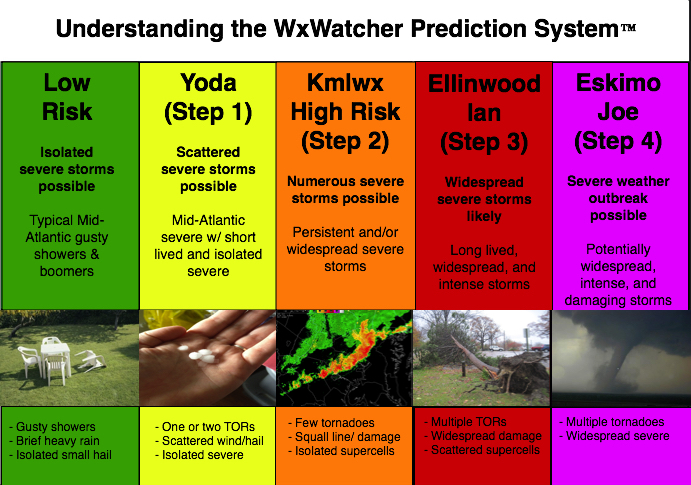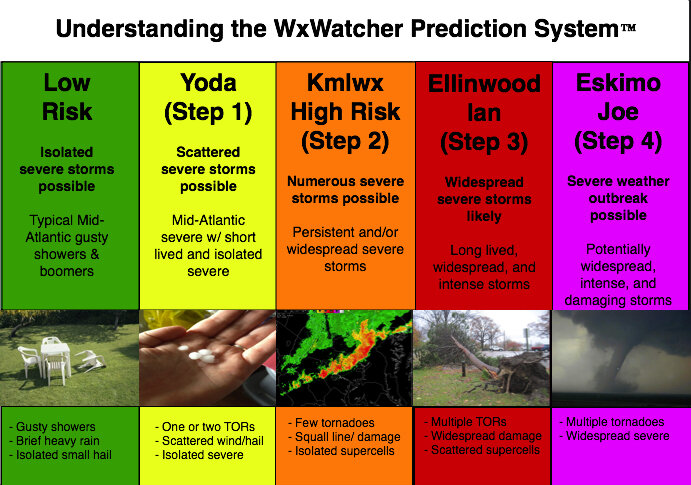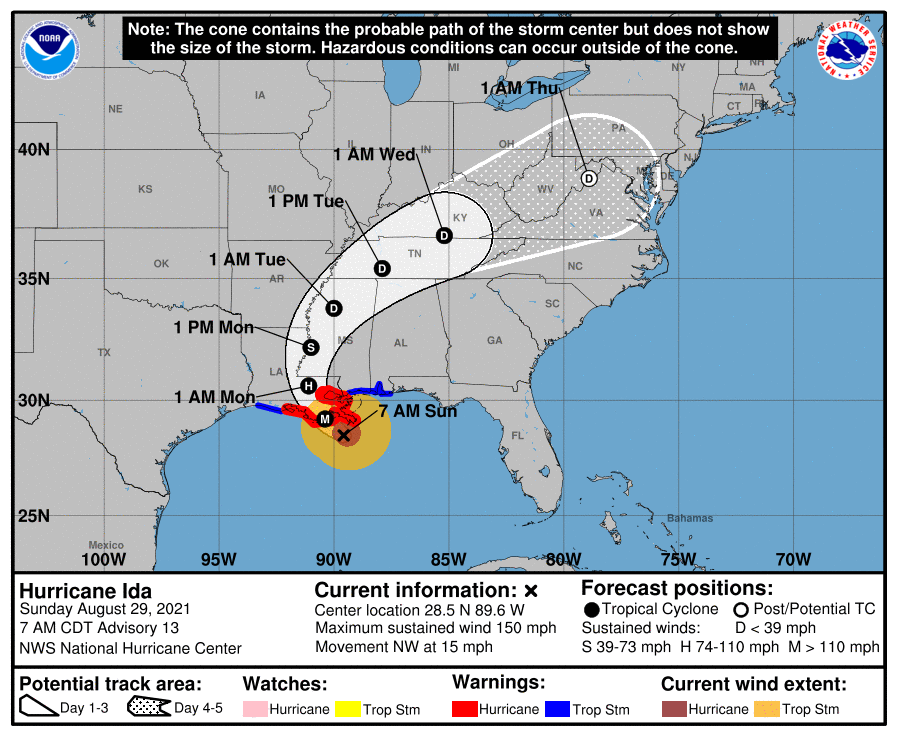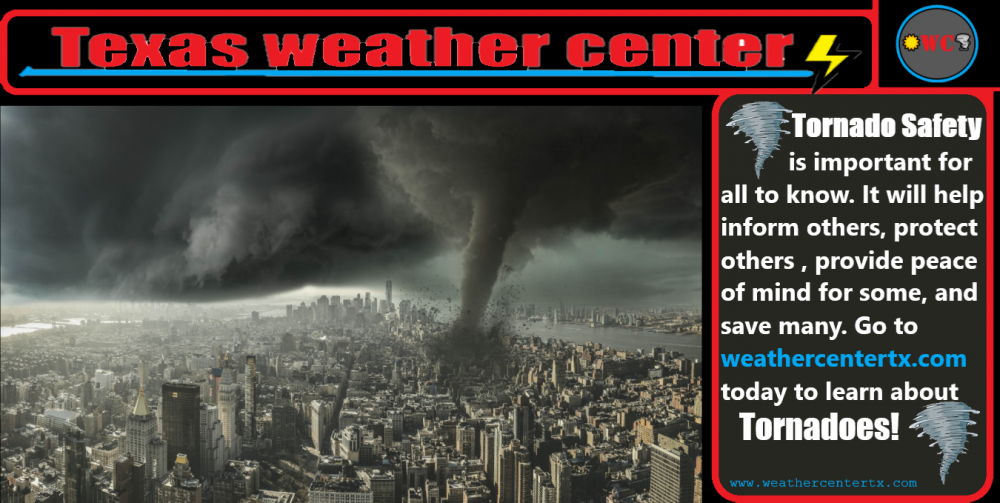Search the Community
Showing results for tags 'Tornadoes'.
-
The GFS joined the Euro with some potential snowy hi-jinks to welcome met spring. As was noted, virtually all decent March/April snows over the last 50 years featured a cooperative or at least non-hostile pacific and MJO in Phase 2/3. It looks like we may be hanging out in 2 around the time the snowfall is showing up on the models.
- 87 replies
-
- 6
-

-

-
The 2025 iteration needs an early start due to a marginal threat for severe tomorrow (2/16)! Have at it!
- 451 replies
-
- 8
-

-

-
- severe
- thunderstorms
-
(and 2 more)
Tagged with:
-
It's early, but might as well do the annual severe thread (people were talking about it in the long range thread!). I don't have the @WxWatcher007 scale handy on this computer - but I usually post it for posterity for the upcoming severe season. Anything from discussing past events to potential upcoming patterns/analogs, and discussion about more specific upcoming threats can be posted in here. A while ago we stopped doing event-specific severe threads for most things. Whether we do that or not - this is the general thread. Have at it!
- 1,696 replies
-
- 3
-

-
- severe
- thunderstorms
- (and 5 more)
-
I'm guessing I'm not the first person on the board who started watching the videos, but YouTube somehow knew to suggest Convective Chronicles. Tropical Tidbit style discussions of ongoing events, and 45 minute post-mortems of significant tornado events of the last 30 years. On Twitter/X and YouTube.
-
Given that there is a tiny chance at something next week, we'll go ahead and open up the 2023 iteration of the thread. I doubt it will amount to much of anything (perhaps a better chance in the Carolinas and far SEVA) but we'll see. General mid to long range discussion can go in here, as can discussion about past events etc. In past years this has also served as a bit of an "on the fly" obs thread for events that are too small to warrant a separate thread. Pretty casual rules in this annual thread. Looking forward to our usual folks And as always - attached is the @WxWatcher007 tier system for our severe threats here in the Mid-Atlantic subforum.
- 2,785 replies
-
- 9
-

-

-
- severe
- thunderstorms
-
(and 3 more)
Tagged with:
-
Mid February is usually when the early peeks at severe can sometimes start showing up. Judging by the models and the long range thread, looks like maybe a marginal threat for Thur night? General severe discussion, remembering past events, and all that usual stuff that goes in here each year can go in here again. Hopefully we get some good thunderstorms this spring and summer. Looking forward to plenty of copy and pasting from @yoda, downer posts from @Eskimo Joe, great analysis by @high risk, and plenty of sun obs that turn into nothing. Giddy up! And for humor sake - see below
-
- 487 replies
-
- hurricane
- flooding potential
-
(and 2 more)
Tagged with:
-
Thursday will be a regional severe wx outbreak. @CheeselandSkies I think SPC was waiting for American guidance to come toward the ECMWF. It was stubbornly slow this time. Regardless of how we got here, we are at hatched ENH Day 3 now. First thing I noticed with 12Z guidance is that 500/200 mb winds are forecast WSW. Some of the sloppy South days those winds are SSW. From the SW is plenty of turning. From the WSW as forecast offers robust turning with height. No strange 700 mb winds, smooth forecast hodographs. LLJ is still forecast S or SSW, correct for South severe, even on the squirrelly GFS runs. Winds of course strengthen with height too. Warm sector looks a little bigger than last week defined by northward extent of the synoptic warm front. That does not necessarily mean intense severe weather farther north. That'll depend on the outflow boundary situated south of the warm front, and influenced by midday rain. Undisturbed warm sector soundings should have a little EML and lots of instability. Background pattern is there for a severe weather outbreak. Mesoscale details remain up in the air as usual Day 3, including the size of the region impacted.
- 164 replies
-
- 8
-

-

-
- tennesse
- mississippi
-
(and 6 more)
Tagged with:
-
Here, you can learn what tornadoes are, what destruction they can cause, how to prepare for a tornado, how to properly execute tornado safety, what warnings and watches are, what to do during a tornado, where to be during a tornado, and what to do after a tornado! Tornado Safety Texas Weather Center
-
It's March...and even though we probably have a few more winter weather threats ahead...it's time to launch the 2019 Mid-Atlantic Severe Wx thread. Pattern stuff can go in here, discussion leading up to events and more. Same guidelines as past years. Thread will probably idle for a month or two - let's hope for some general excitement this year.
- 2,802 replies
-
- 2
-

-
- severe
- thunderstorms
- (and 4 more)
-
As the pattern over North America shifts, an extended period of potential severe thunderstorms targets the central U.S. Although this update covers May 6-10, thunderstorms are ongoing today (May 5th) and were prevalent in prior days as well. The difference here is that we are gradually starting to see more and more potentially potent setups on the horizon. Wednesday, May 6th: This day has been on the radar for a while and things are coming into somewhat better focus. As shortwave energy pivots from the High Plains to central/northern Plains on Wednesday, an area of surface low pressure will develop. With more forcing in place than prior days, that alone signals an enhanced severe weather threat. — By Wednesday afternoon, a portion of the surface low should be crossing over from far eastern Colorado into western Kansas. The strongest forcing should reside from northwestern Oklahoma into central Kansas. However, the greatest instability will likely be displaced further south from central Oklahoma down into north Texas. Partial to considerable cloud-cover will tend to limit the amount of destabilization that takes place. That combined with modest flow at 500mb, progged to be on the order of about 35 to 45 knots, will tend to limit the extent of the severe weather potential. The surface low itself is also a bit elongated. If it were more concentrated and also deeper, that would signal a greater severe thunderstorm potential. Nonetheless, with a tongue of 1,000 to 2,000+ J/kg CAPE, favorable speed and directional shear, and some forcing aloft should favor at least scattered severe thunderstorms by mid to late afternoon. — In terms of severe threats and the areas to watch… It comes down to northwestern Oklahoma into central Kansas for what should be the greatest severe threat. More isolated severe storms are still possible along a dryline down into western and central Texas. Large hail, perhaps very large in a couple of storms, appears to be the most significant risk. Damaging winds will be possible, especially into the overnight as storms may tend to merge into lines. There is a tornado threat, which should be maximized during the early evening hours, as the low level jet ramps up. As has been the case many times this year, while there is an evident tornado threat, the intensity and duration of any tornadic storms will be dampened somewhat by the limiting factors mentioned above. There is a fairly good likliehood that multiple tornadoes (but not a major outbreak) will be reported late Wednesday afternoon into Wednesday evening. Thursday into Friday, May 7th and 8th, also provide some severe weather threat, but in a more isolated and sporadic nature. Upper level heights should remain fairly neutral through the period with no significant forcing noted in the models. Each day is likely to feature moderate instability and at least marginally supportive wind shear for supercell thunderstorms. The corridor for this period should be narrowed in on the Texas panhandle, portions of interior Texas and into Oklahoma. While some severe threat may nudge into portions of Kansas, the greatest (still somewhat limited) threat should hang back further south. Each day, storms may produce large hail with some damaging winds and a few tornadoes. — Each day, watch for a few things: First, where is the greatest instability? If cloud-cover and convective debris are limited during the morning, expect a somewhat enhanced severe weather threat during the afternoon. Also, look for any outflow or other mesoscale boundaries that can be the focal point(s) for storm development. Finally, notice any upper level perturbations, even if seemingly minor, as they could provide just enough forcing to locally increase the severe threat. Saturday, May 9th has the potential, but the keyword is potential, to be a significant severe weather outbreak with numerous tornadoes. The overall pattern is favorable, as a trough swinging from the Four Corners region to eastern Colorado/New Mexico by late-day will provide ample forcing from the High Plains into portions of the central to southern Plains. Caution must be applied when looking at the analogs, but there is a fairly strong signal from the analogs that favors widespread severe thunderstorms and at least isolated significant severe events, including strong and/or long-track tornadoes. — Now, even though some major events show up in the analogs, there are a few limiting factors that will not favor a high-end outbreak. While the flow and forcing increase aloft, 70-80 knots at 300mb and 50-60 knots at 500mb will fall well short of an event such as 4/14/12, which showed up as a GFS-based analog. As far as instability, even though moderate CAPE values are predicted, we’re not looking at strong to extreme instability. There seems to be a common theme, with this week especially, that the atmosphere is not quite taking full advantage, resulting in a less extreme “than possible” setup. — With all of this said, even if the timing is not exactly right, and the timing looks pretty favorable right now, severe thunderstorms are strongly favored on Saturday. What will be the difference between a low-end event and a more significant outbreak will come down to mesoscale details. What also favors severe weather on Saturday is how the models, overall, have been in very good agreement with the general setup on Saturday for quite some time. The focus on Saturday ranges from north Texas through much of Oklahoma and Kansas, to perhaps as far north as portions of Nebraska. All severe weather modes are anticipated, with an enhanced risk of tornadoes. Sunday, May 10th is a bit further out there, but yet another severe day is quite possible. Details are a bit more muddled, as the evolution of Saturday will have a sizeable impact on what transpires on Sunday. The threat zone inches somewhat east, ranging from portions of Texas up through central and eastern Oklahoma, eastern Kansas and perhaps into portions of Missouri and Arkansas. In summary, expect severe weather threats for the rest of this week and likely through most of this weekend across the central U.S. At least a few severe thunderstorms are expected each day, with scattered severe storms on Wednesday and perhaps a mode widespread and significant event on Saturday. Tornadoes are possible each day, but the day with the likelihood for the most tornadoes is also Saturday. In terms of storm chasing, there should be many quality opportunities to get out in prime real estate, from the High Plains into the Plains west of I-35. With the threats covering a long period over some similar areas, it may be worth while to hunker down and start thinking of possible targets or even just places to stay (if you’re planning a multi-day trip). Without giving too much away, and since details may change, I tend to favor a corridor from the Texas panhandle into southwest and central Kansas. Climatology also favors this zone for the greatest severe weather threat and trends this year have kept the dryline a bit further west, mainly across these areas, during most events.
-
Over a 50-year span from 1962 to 2011, the most violent (F/EF-4 and F/EF-5) tornadoes occurred over Oklahoma and Mississippi. The maximum grid-points reported 16 over that period, with two of those grid-points in central Oklahoma and one in central Mississippi. While a broad area from the Plains to the mid-South sees the most tornadoes overall across the United States, there are three sub-areas with the most violent tornadoes. Much of Oklahoma falls into that category, as it is widely considered to be in the heart of tornado alley. Further north into Iowa is another area that has seen the most violent tornadoes during the period. The third area falls across Mississippi, where the tornado season is relatively elongated from the heart of winter into mid-Spring. The tornado season in Oklahoma generally occurs in a narrower window in mid-Spring. The season in Iowa tends to fall from mid to late spring with a secondary peak in the fall. A smaller and less significant maximum for violent tornadoes can also be identified across the upper Ohio Valley. While the tornado season tends to peak there in mid-Spring, a few events have also occurred in the fall. An interesting tornado minimum occurs in a small portion of central Missouri. Among multiple factors is the unique geographical area Missouri falls into. The classic tornado setup in the Plains is driven largely by lee-side cyclogenesis and the dryline. As storm systems move across the Plains, the bulk of the violent tornadoes tend to occur west and northwest of Missouri. Also, the dryline tends to have trouble advancing enough east to penetrate far into Missouri. Likewise, typical tornado events in the mid-South tend to thrive off of moisture from the Gulf of Mexico, producing tornadoes east of Missouri. With that said, higher instances of violent tornadoes have been noted across northwestern Missouri (tornado alley), far southeastern portions of the state (Dixie alley) and the devestating EF-5 tornado in Joplin, in far southwestern Missouri in 2011. East of the Appalachians, violent tornadoes are fairly uncommon. However, two particular regions have reported three or more violent tornadoes from 1962 to 2011. Portions of the Carolinas fall into that category. Further north, grid-points in the mid-Hudson Valley into southwestern New England have reported four violent tornadoes in that same span.
-
The April tornado forecast was a trial run and a lot has been learned since it was made. After some success with that forecast, I will be incorporating a lot more statistical analysis (analog data) into coming up with a forecast for the month of May. Quickly recapping April: Overall, April was a fairly steady month for tornado reports across the U.S., with 21 out of 30 days reporting tornadoes. April 1-9 was very active, including a notable, early season EF-4 tornado in northern Illinois. April 10-18 was relatively inactive, but had tornadoes reported in all but two of those days. April 19-27 was rather active, but no single day featured a major or significant outbreak. Most of the tornadoes in the month were EF-1 or weaker, although the April 9th EF-4 was an exception. Preliminary tornado counts indicate that the month was near to slightly below average in tornado activity. The prior forecast issued on March 31st predicted slightly above average tornado counts. Once the numbers become official, I will get into more detail with comparing the forecast vs. actual. Before we get into May, there are some things to consider with the current state of the U.S. Although a long-term drought continues for much of the Plains, heavy rainfall throughout April reduced drought conditions considerably across portions of Oklahoma and Texas. This is critical, because relative tornado inactivity during the first half of spring 2014 across the Plains was at least partially attributed to a lack of available moisture. When we think about creating environments that support tornadoes, moisture is key and that moisture source can originate in Texas. Yes, the Gulf of Mexico is another player, but that moisture must also be able to track hundreds of miles inland, across the big state of Texas. Additionally, the overall atmospheric pattern has shifted somewhat, as although there has been continued troughiness across eastern Canada and the Northeast, we are seeing a trend toward more ridging developing. This will have many implications on how the tornado season evolves into May. With less blocking across northeast Canada toward the North Pole, that should tend to favor positive height tendencies as well. (Not to mention seasonality helps with that as well) For this outlook, the focus will be split into two portions. May 1-10 and May 11-31. I will still include breaking the month down into thirds at the end of the outlook, but keep in mind that specifics beyond May 10th lack the confidence needed to get into extreme detail in that time period. May is also a potentially volatile month, as one outbreak or even one day for tornadoes can effectively skew the big picture. It would be difficult to nearly impossible to predict any such outbreak more than 10 days in advance. The point of this outlook is to look at May as a whole. May 1st through 10th: After a quiet finish to the tornado season in April, the first few days of May look to continue that theme. This should not last long, though, as both the operational and ensemble forecast models are in strong agreement with the expected pattern. On paper, it looks encouraging for severe weather prospects. An upper level trough and surface low should exit the New England area may May 3rd, leaving the Lower 48 with a relatively zonal pattern, at least for a short-time. Downstream ridging across the East should give way to a digging trough across the West Coast by May 4th to 5th. With some blocking across eastern Canada, we are looking at western U.S. trough that will persist for several days, with potentially multiple impulses rotating around from the Intermountain West into the Plains. This could ultimately evolve in many ways. At this point, the most probable scenario would appear to be two to three, perhaps four, days that are conducive for minor to moderate severe weather events, including tornadoes. I would not want to write off the potential for a big event just yet, but it seems more likely that we will have a series of smaller events, kind of how April panned out. What will be working in the favor of severe weather will be the bonus of a better moisture source across the southern Plains and moderate to strong instability ahead of approaching shortwaves. It is the details that get somewhat muddled out, with the amount of clearing/destablization, storm mode, locally backed winds, etc. Essentially, the pattern looks favorable for severe weather and tornadoes, particularly between May 5th and 8th. As mentioned before, maybe only two of those days wind up decent for severe, but if the pattern lines up just right, there could be multiple tornadoes each day. Verdict: Near average tornado activity between May 1st and 10th. The period should begin quiet, but then see multiple days with at least modest tornado activity. The period may close out with a couple of quiet days as the pattern trends more zonal, assuming the model projections are correct. May 11st through 31st: I have put a lot of time into assessing analog data for this period and not so heavily relying upon forecast model ensembles, as was the case with the April tornado outlook. What has been most alarming lately is that the longer-range models have really struggled beyond day 10 over the past several weeks and have often showed little to no skill in the period of days 15 to 30. This means that the models have flip-flopped back and forth, giving little meaningful insight to what might lie ahead. Now, I am not totally discounting the models here. Sometimes they can struggle during a large scale pattern change, much like what we may be seeing into May. I put a fair amount of stock into the European ensembles/weeklies, but I think taking a look at the past will help shed some light on what might happen in the future. To come up with analogs, I have looked at two things in particular. First, I assessed the short-term model analogs for May 1-2. Secondly, I looked at the day 6-10 ensemble predictions from the GEFS and those analogs. There was some overlap and plenty of similarities to note. In the broad scheme, the analogs began with the western troughing/eastern ridging that we are expecting to see into the first week of May. The analogs are then in strong agreement with positive height anomalies along and east of the Rockies from the 2nd week of May, pretty much through the entire month. After gaining visibility to the latest 00/30 Euro Weeklies, pretty much the same is the case here. That only increases confidence in this forecast. I pretty much disregarded the CFS entirely for this outlook, as its members are all over the place for May and as an ensemble system, has not had a good track record as of late. Going back to the ridge axis, that is the key thing to consider. The indications, in general, point toward a mean ridge axis setting up somewhere between the Missouri River and the Mississippi River. The latter, or a further east ridge axis, would be more supportive of tornadoes, allowing for troughs to dig a bit further south and west into the Plains. Even the former would be encouraging, as it would tend to favor High Plains activity. That region has not had a great chase season in a while. Based on the reports, it appears as if 2010 was the last solid year there and 2008 was decent too, particularly across western Kansas. Either way, since we are looking at a broad period here and kind of splitting hairs, there is nothing necessarily stopping from a rogue, deep trough to swing through, although it would appear that if that was going to happen, it would tend to favor late May over mid-May. As a result, I am leaning toward a somewhat more active end to May, even though I do expect a fair amount of activity in the middle of the month as well. (When I say fair amount of activity, I expect several days with scattered severe reports, again, in some ways similar to what April featured) Verdict: Near average tornado activity between May 11th and 31st. The middle of May holds some potential, but is forecast to feature slightly below average tornado reports. Into late May, there are some indications that tornado activity could rebound to near to slightly above average levels with more potential activity. When looking at some of the recent analogs (over the past 25 years), 3 out of 4 had slightly to moderately below average tornado counts in May. On the flip side, they tended to favor average to even very active months of June. Since May 2015 does not appear to be a particularly close match to any of those analogs, I would take that information with a grain of salt. If anything, it does give at least some additional confidence in the thinking that May could end more active and lead into another active June. I do not want to get ahead of myself here, so we will hold off on further discussion about June until the next monthly tornado forecast. May 1-10 forecast: Near average tornado counts in the U.S. May 11-20 forecast: Slightly below average tornado counts in the U.S. May 21-31 forecast: Near to slightly above average tornado counts in the U.S. May 2015 tornado estimate: 260 tornadoes in the U.S. (near to slightly below average) For those wondering, the top 5 analogs are as follows, beginning with the given date and extending out 20 days: 4/28/1994, 5/12/1991, 4/28/1957, 5/10/1993 and 5/18/1977, in that order. The “recent” analogs mentioned earlier in the post were 1990, 1991, 1993 and 1994.
-
The United States has a greater frequency of tornadoes than most other counties. For many factors, the vast majority of tornadoes occur east of the Rocky Mountains across the continental U.S. Although the central and southern Plains region is widely considered to be "Tornado Alley," there are other areas that see just as many tornadoes, if not even more. The two graphics below are adaptations of NOAA/NWS SPC graphics found in their Tornado Environmental Browser. A broad area from the east slopes of the Rockies east to the west slopes of the Appalachians typically see the most days with tornadoes per year. Two local maximums can be identified in northeastern Colorado and central Florida. While these areas may see numerous tornadoes in any given year, they are generally low on the EF-scale. The central Appalachians feature a local minimum of tornadoes, but as one travels east, the frequency of tornadoes increases. While terrain by itself will generally not have much of an effect on a tornado, especially a significant (EF/F-2 or stronger) one, there are reasons why terrain affects tornado frequency. In the Plains, lee cyclogenesis combined with a surge of warm, moist air from the Gulf of Mexico and drier air from the Rockies tends to create a favorable setup for severe thunderstorms and tornado development. Across the East Coast, there is less real estate to work with when considering the proximity to the Atlantic Ocean. Also, wind out of the south to southeast in the lower levels will often mitigate the risk of severe thunderstorms, especially in the spring and early summer months from the mid-Atlantic region into the Northeast. The placement of a "Bermuda" high and/or a "southeast ridge" of high pressure will tend to limit the formation of strong non-tropical low pressure systems along the East Coast during the warmer months, as the jet stream is often displaced further northwest. The frequency of days with significant tornadoes is in some ways similar to, but also has differences in comparison with the frequency of days with all tornadoes. While portions of Colorado and Florida may see the most tornadoes overall, there are two distinct areas that feature a much greater frequency of significant tornadoes. The southern Plains into Dixie Alley (lower to mid-Mississippi Valley) will on average experience the most significant tornado outbreaks. Here, there are three factors that are probably most responsible for this. First, their proximity to warm, moist air from the Gulf of Mexico fill favor higher dew-points and greater instability. Second, the tornado season is a bit elongated here. While April into May have featured the most significant tornadoes in Dixie Alley, the late fall into winter months have also included several major tornado outbreaks. Finally, there may be at least some influence from tropical systems. While tropical storms and hurricanes often do produce tornadoes, it should be noted that most of these tornadoes are generally not significant. Eastern Nebraska into the Midwest also averages an elevated number of days per year with significant tornadoes. Here, while the tornado season typically peaks in June, at least some fall tornado events have spawned significant tornadoes this far north. In 2013, October 3rd-4th recorded six significant tornadoes from eastern Nebraska into Iowa, with the major tornado outbreak of November 17th featuring 32 significant tornadoes in the Midwest. Other noteworthy observations: Missouri is an interesting case. The western portion of the state is often considered to be in tornado alley and some maps will place southeastern Missouri in Dixie Alley. The state has seen plenty of significant and even violent tornadoes, with the Joplin tornado of 2011 being one of the more recent examples. However, a small section of central Missouri features a local minimum in terms of both tornadoes and significant tornadoes. One possible explanation can be their location being in a "dryslot" of sorts for tornadoes. For storm systems developing just east of the Rockies, the eastward extent of associated severe weather will often fall short of central Missouri. Likewise, systems developing in the lower Mississippi Valley often form a bit too far east to target central Missouri with the most tornadoes. West Virginia has less tornadoes than most states east of the Rockies. One factor that immediately comes to mind would be the population density and terrain, which may limit some tornado reports. However, their location along the Appalachians certainly plays a role in the lower frequency of tornadoes. The higher elevations will typically have less instability. Likewise, moisture pooling will typically favor higher dew-points west and east of the Appalachians, leaving West Virginia in another tornado dryslot. According to the NWS, West Virginia has no recorded EF/F-4 or 5 tornadoes. With that said, a long-track F-5 tornado in southeastern Ohio narrowly missed passing into West Virginia before lifting. Also, an F-4 tornado that dropped southeast of Pennslvania into Maryland also lifted shortly before it would have passed into West Virginia.











